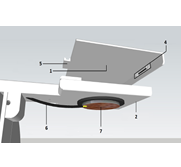Prototype of a Device to Research Ultrasound Effects on Microbiological Processes
Main Article Content
Keywords
Continuous ultrasound, laser nephelometry, microbiological processes, micro-incubator, pulsed ultrasound, sonication, ultrasound biophysics.
Abstract
This article describes the development of a multifunctional prototype which supplies ultrasound to a sample in a Petri dish, between 18 KHz and 30KHz frequencies, with intensities from 0.3 mW/m2 to 1.5 mW/m2. This device guarantees sample survival with a micro-incubating system, operated by a control system and temperature monitoring. In addition, the prototype detects changes regarding the microbiological process in question, with a self-based laser-nephelometry system. The user would be able to choose parameters values mentioned, for a certain experiment, and analyze output data tables, images and statistics generated by a computer application specially designed to present this data.
MSC: 92-XX
PACS: *43.35.-c; 43.35.+d; *43.80.-n; 43.80.+p; 87.50.Y
Downloads
References
[2] V. Frenkel, Therapeutic ultrasound: Mechanisms to applications. New York: Nova Science Publishers, 2011.
[3] N. Doan, P. Rehem, S. Meghji, and M. Harris, “In vitro effects of therapeutic ultrasound on cell proliferation, protein synthesis, and cytokine production by human fibroblasts, osteoblasts, and monocytes,” J Oral Maxillofac Surg, vol. 57, pp. 409–419, 1999.
[4] L. J. M. Juffermans, P. A. Dijkmans, R. J. P. Musters, C. A. Visser, and O. Kamp, “Transient permeabilization of cell membranes by ultrasound-exposed microbubbles is related to formation of hydrogen peroxide,” American Journal of Physiology - Heart and Circulatory Physiology, vol. 291, no. 4, pp. H1595–H1601, 2006. [Online]. Available: http://ajpheart.physiology.org/content/291/4/H1595
[5] W. Wei, B. Zheng-zhong, W. Yong-jie, Z. Qing-wu, and M. Yalin, “Bioeffects of low-frequency ultrasonic gene delivery and safety on cell membrane permeability control,” Journal of Ultrasound in Medicine, vol. 23, no. 12, pp. 1569–1582, 2004. [Online]. Available: http://www.jultrasoundmed.org/content/23/12/1569.abstract
[6] M. Madigan, J. Martinko, J. Parker, and T. Brock, Biología de los microorganismos. Madrid: Pearson, Prentice Hall, 2004.
[7] WHO, Laboratory safety manual. Geneva: WHO library, 2004.
[8] I. E. Commission, 61010-1 Safety Requirements for Electrical Equipment for Measurement, Control and Laboratory Use-Part 1: General Requirements, Geneva, 2010.
[9] E. Corporation, XR-2206 Monolithic Function Generator Application Note, Kato Road, Fremont, CA, 1997.
[10] K. G. Baker, V. J. Robertson, and F. A. Duck, “A review of therapeutic ultrasound: Biophysical effects,” Physical Therapy, vol. 81, no. 7, pp. 1351–1358, 2001. [Online]. Available: http://ptjournal.apta.org/content/81/7/1351.abstract
[11] S. Robinson, Driving Piezoelectric actuators, Tuczon, Ariz, 2006.
[12] W. L. Nyborg, “Biological effects of ultrasound: Development of safety guidelines. part ii: General review,” Ultrasound in Medicine and Biology, vol. 27, no. 3, pp. 301–333, 2001, cited By (since 1996):112. [Online]. Available: www.scopus.com
[13] L. A. Love and F. W. Kremkau, “Intracellular temperature distribution produced by ultrasound,” The Journal of the Acoustical Society of America, vol. 67, no. 3, pp. 1045–1050, 1980. [Online]. Available: http://link.aip.org/link/?JAS/67/1045/1
[14] WHO, Environmental Health Criteria. Geneva: WHO library, 1982.
[15] K. J. Astrom, “Contro system design lecture notes for me 155a,” pp. 217–237, 2002.
[16] S. Angersbach, B. Hipler, S. Brand, and C. Ruckert, “Monitoring of microbial growth curves by laser nephelometry,” GOR-TOKYO-, vol. 7, no. 4, p. 35, 2005.
[17] M. Sadar, Introduction to laser nephelometry: an alternative to conventional particulate analysis methods, Loveland, CO, 1999-2005.
[18] B. H. Brown, R. H. Smallwood, D. C. Barber, P. V. Lawford, and D. R. Hose, “Medical physics and biomedical engineering,” Measurement Science and Technology, vol. 12, no. 10, p. 1744, 2001. [Online]. Available: http://stacks.iop.org/0957-0233/12/i=10/a=703

